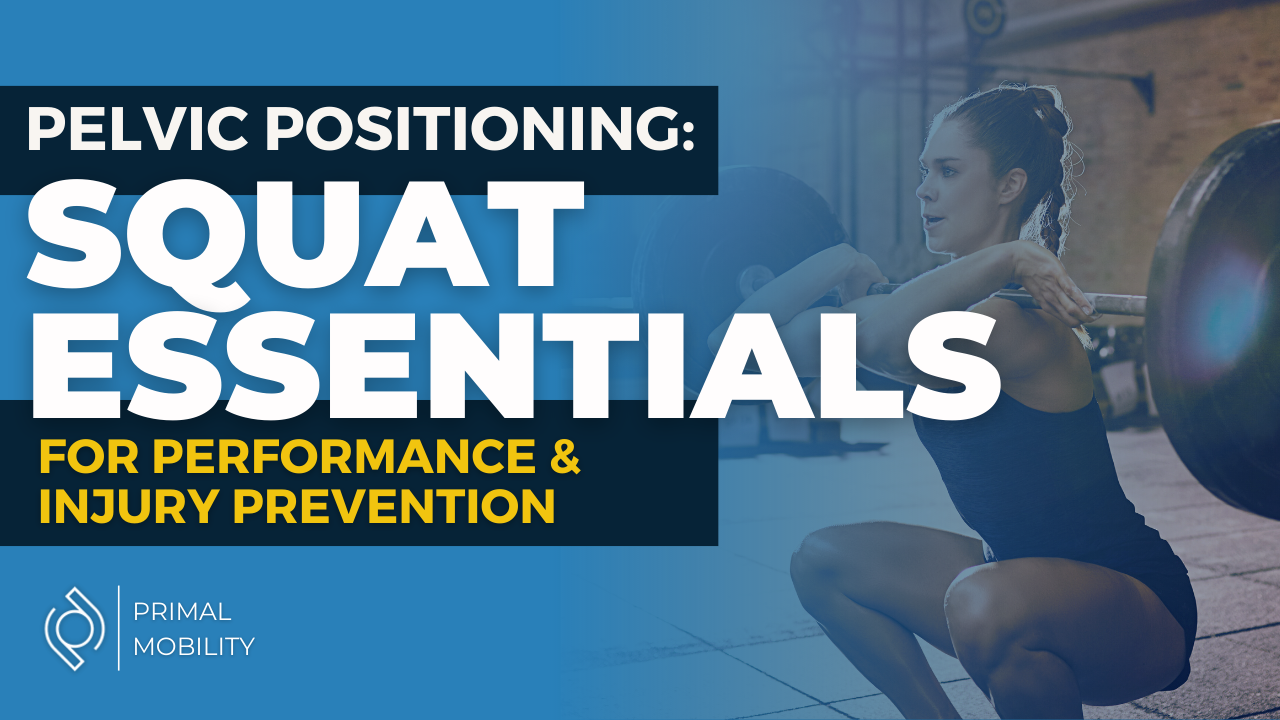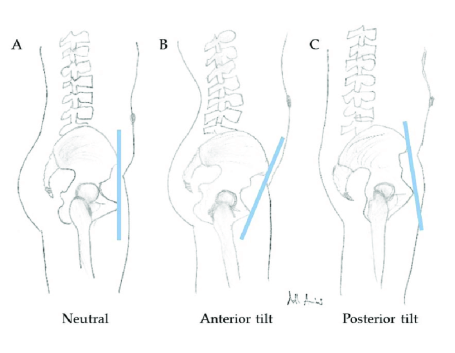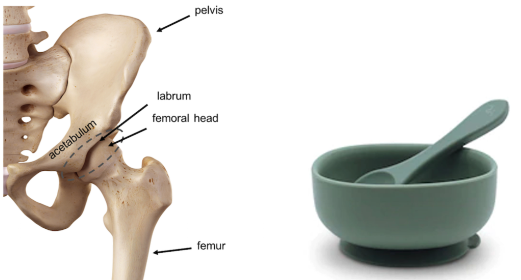
Have you been addressing your clients' hips and ankles but still aren’t seeing progress in their squat mobility or overall squat mechanics? Well, it may be far more simple than that - it may be locked up in their pelvic positioning and their lack of awareness of their squat positioning in general.
In this article, we are going to discuss how the position of the pelvis can greatly affect the squat pattern in terms of how your clients feel, as well as the range of motion they’re able to access. As you read through, my goal is to help offer you tools to address the situation and make sure you leave here feeling well-informed on how to take action.
Let’s dive in!
Pelvic Positioning and Squat Mobility
When it comes to squatting, comfort and confidence in the body are key for power output and overall performance. If your clients are feeling any sort of discomfort or pain, it can ruin the experience for them and limit the amount of energy they’re able to put toward the movement. While this definitely isn’t the “end of the world” for the general population, anyone who truly gives a rats ass about their performance and longevity is going to be serious about improving this (I’m going to assume a decent % of your client base is in that camp).
When we’re talking about the positioning of the pelvis impacting squat mobility, it’s mainly in one direction - an anterior tilt. This is when the pelvis tilts forward (at any point in the squat pattern). When someone is standing in an anterior pelvic tilt - which is wildly common, by the way, many people naturally rest in this position - the hips are forced into slight flexion (which shortens the hip flexors), and the tilting pulls the hamstrings into length. Causing both of these muscle groups to be nearer to their end ranges. To make all of this more clear, once your hips are at their end range, they have no more range to offer to the squat pattern.
One of the most simple “tests'' to do to determine if someone has an anterior pelvic tilt that may be affecting their squat pattern is to look at their belt line. If the belt line is tilted forward, chances are they have some degree of tilt. If you notice this beltline drastically changing angles as they begin their squat pattern, they are likely placing their hips in deeper flexion and reducing the amount of range of motion they can access during the pattern as a result.
Here is a video displaying how the anterior pelvic tilt can limit the squat pattern and even cause a butt wink.
Recognizing Symptoms of Improper Pelvic Positioning
If you reviewed the video above, you now know that an anterior pelvic tilt will place the lumbar spine into extension, the hip flexors will shorten, and reduce the amount of range of motion your client can achieve in their squat pattern. Before we go any further, I believe it’s important to clarify that this is not necessarily an inherently bad thing. Only if your client is performing their squats like this over and over again will there be any issues that result from it - and unfortunately for many, squatting with a tilted pelvis has become a habit in their squat pattern.
In order to help your clients avoid discomfort, pain, and potential injury, we’ll want to make sure that you first become aware of the situation as their coach and, second, understand how to address it (we’ll get to that through this article). As mentioned, the anterior pelvic tilt in the squat only becomes an issue if the client continues to perform their patterns like this on an ongoing basis, and the longer they squat in this pelvic position, the more they increase their chances of discomfort, pain, and injury.
So if you start to notice that your client really struggles to pass parallel in their squat, you should also pay attention to any symptoms that may be coming up as well. Low back discomfort and hip flexor tightness or “pinching” in their squat are two common issues that are frequently noticed in this situation.
The Relationship Between Pelvis, Hips, and Femur in Squatting
Let’s paint a little picture for clarity here - as we squat, our femur will move in and around (almost like a swivel motion) the hip acetabulum (socket). Depending on the depth/shape of the socket, there will be a particular amount of potential range of motion that it is capable of. Now, when we move our pelvis, this inherently moves our acetabulum, which changes the position of the femur. When we are in an anterior pelvic tilt, the femur is pushed anteriorly (forward), which will naturally take up some of the potential ROM capacity from the hips (Fig. B).

Another potentially helpful perspective: Anytime the femur moves, it takes up space within the hip socket. Once that space is completely taken up, the hips will have no more ROM to offer, which will then cause the pelvis to shift to make up for it. Think of this like a spoon in a bowl. The spoon only has so much area to move around in, and once the spoon reaches/leans up against the edge of the bowl, if the spoon continues to move (with enough force), it will tilt the entire bowl over. The same happens with the femur, acetabulum, and pelvis.

Anterior Pelvic Tilt Effects on Squats
Now that we’re clear on the fact that performing a squat pattern with an anterior pelvic tilt will limit the amount of depth you’re able to achieve - due to the amount of hip flexion that is accessible to move through throughout the pattern - let’s chat about what type of effects this can have on particular muscles as a result.
Hip Flexors: When the hips are in flexion, the hip flexors are in a shortened position. Moving through a squat pattern with an anterior pelvic tilt can have the hip flexors reach their shortest position very early in the squat, which can cause discomfort and/or pinching-type pain.
Glutes: Everyone wants a big ole booty and thinks that squats are the answer - but that isn’t always the case for everyone. For the glutes to get a great stimulus through the squat pattern, they need to go through a process of stretching and contracting. This is achieved at a much greater degree when the person can get into a deep squat position. So plain and simple, if you can’t squat past parallel, your glutes won’t be getting the best bang for their buck here!
Benefits vs Drawbacks of Anterior Pelvic Tilt
I know I’m painting a pretty negative picture about anterior pelvic tilt, but there are absolutely some benefits to capitalizing on that particular position of the pelvis as well. Let’s have a quick look so that it’s clear when APT can help you out vs when it can limit your potential.
Benefits:
- Increase stretch through hamstrings and glutes in a hinge pattern (the spinal extension experienced during an anterior pelvic tilt will help place the lower posterior chain under tension)
- Potential increase in speed/explosiveness during running or jumping activities (the pelvic tilt can increase the amount of range the individual can access in their step and extension phase through the jump)
Drawbacks:
- Limited depth in squats
- Increase stress and potential injury risk to hip flexors
- Can make it more challenging to connect and engage the hamstrings & glutes
Assessing A Squat Pattern
As a coach, you are likely always looking for ways to hone your craft and become better at what you do. One of the best ways to set yourself apart is to become knowledgeable in an area that is often unclear or potentially misunderstood. One of those areas is mastering the understanding of movement mechanics. Once you begin going down this road, you will become very clear on what functions of the joints need to be prioritized with mobility training to achieve particular results.
One of the most important things you can do as a mobility coach (or a coach who is genuinely interested in improving the function of your client's body and performance) is to understand how to assess a squat pattern. From the stance to the pelvic alignment to the position that the barbell sits on the individual's body, how can this all change the movement requirements and range of motion demands being placed on your client? This is all-important for you to grasp and acknowledge.
It all starts with the ability to assess the squat - from the bodyweight squat to an overhead squat, how the body is being challenged and what is the range of motion requirements.
First things first, you really just have to start practicing. Of course, there are always going to be pieces to the puzzle that you don’t understand yet (which is why you should continue to invest in continued education), but the only way to continue improving is to get your reps in! Start by asking your clients to film their squats from the front and side (this can be both loaded and unloaded) and send it to you so you can analyze the pattern.
Filming techniques for analyzing back squats
In order to have the best opportunity for quality analysis, you’ll have to make sure you get an appropriate video to work with! If the angles and requirements are all off, then it becomes increasingly more challenging to truly understand how the body wants to move.
Here are a few pointers to suggest to your client in order to get the best result:
- Must be barefoot to avoid any heel elevation (we’re looking to see what their true mobility looks like)
- Avoid wearing baggy clothes (makes it really challenging to see what’s happening)
- Wear something on the wrist to help distinguish left to right (a watch or an elastic band)
- Keep the camera at eye level when they are at the bottom of the squat position
- Avoid filming in front of a window or wearing clothing that matches the background
Identifying signs of unnecessary stress on hips
As a coach, being aware of the signs of compensation that may be stemming from a less-than-ideal pelvic position can be very empowering. This will allow you to reduce the unnecessary stress being placed on your client and quickly improve how they feel in their squat, and increase their overall performance and recovery as a result.
Here is a brief list of things to focus on with your clients to help reduce unwanted stress that can be caused by improper pelvic positioning:
- Pelvis tilting forward (anterior tilt) as they begin the squat pattern
- Knees caving inward (valgus collapse)
- Hip flexors feeling “tight” or pinched at the bottom of the squat
- Lumbar spine rounding (butt wink) when reaching full depth
- A lack of ability to reach past parallel in the squat pattern
Improve Your Client’s Squat Mobility with These Simple Fixes
Whether you’re looking to reduce the discomfort your client is feeling in their squat, improve their overall squat mobility/range of motion, or start your journey as a squat expert, there are a few things to pay attention to give them the opportunity to perform at their best.
Adjust their stance: Not every person or type of squat (front squat, low bar back squat, etc.) will require the exact same stance. Due to hip anatomy, anthropometry (femoral, tibial, and torso length), and mobility limitations, the foot position and width someone may feel comfortable squatting in can be vastly different from another. Consider auditing their squat stance - this can make a massive difference very quickly, and it will make you look like a mobility god by how quickly they will feel the improvements.
Cue proper form: If you notice that the client’s pelvis is tilted throughout their squat pattern, try to offer various different cues and also demonstrate what you are trying to explain. Similar to the speed at which someone can feel a difference in their squat just from adjusting their stance, the same goes for offering demonstrations.
Band-aid solutions: Having someone use a weightlifting belt wrapped as close to the pelvis as possible can offer them instant feedback as to where their pelvis is while squatting (the pressure from the belt can make it feel very clear if they are tilting excessively). You can also suggest that they use a band wrapped around their knees to help them engage their glutes throughout the squat pattern, which can naturally help them maintain a neutral pelvic position throughout the pattern. Keep in mind that these two things are short-term solutions just to allow your client to become more aware of their pelvic position. The long-term goal is to improve that proprioception and then remove the band-aid and let them continue to build their awareness.
Offer targets and cues: Strategically reducing the range of motion can go a long way as well. If your client has yet to build a strong connection and awareness of their pelvic position, it can be exceptionally challenging to maintain that control throughout the deeper ranges of motion. Try to offer a target for them to aim for during their squat pattern to help them focus on control, change the tempo of the squat, and remain aware of their body’s position.
Coaching Clients with Limited Proprioception Skills
Proprioception is a necessity when it comes to high performance. If your client wants to continue improving their ability in the gym (and, of course, reduce the likelihood of injury and discomfort), helping them level up their awareness throughout the patterns will go a long way.
Something to keep in mind while coaching someone who may be newer to their fitness journey, or has never truly worked on their proprioception, is that it can be a long journey. Developing that awareness will take time and can be a frustrating process if you place a lot of pressure on yourself as the coach or the client to figure it out quickly. Rather, just understand that it’s a journey and that your cues and understanding of how your client receives information are vital to their success. Improve your communication skills, and your client will improve their training as well.
FAQs in Relation to Pelvic Positioning Squat Mobility
What is the ideal pelvic position for squats?
The ideal pelvic position for squats involves maintaining a neutral spine, which means keeping your pelvis aligned with your lumbar spine. If you notice an arch in the low back, the pelvis is tilting into an anterior position. If you notice a butt wink, that is the pelvis moving into a posterior position.
Should you “tuck” your pelvis when squatting?
Although a lot of people will say that it helps them engage their glutes, tucking the pelvis excessively during squats can lead to improper form and potential injury risks. A better approach is to teach your clients to feel and engage their glutes!
How do you correct pelvic shift for squats?
To correct pelvic shift in squats, focus on strengthening weak muscle groups such as glutes or hip abductors through targeted exercises like clamshells, lateral band walks, or single-leg deadlifts. This, in combination with proprioceptive work, can be a game changer. Help your clients become more aware of their pelvis during the squat pattern.
How do I get more mobility for squats?
Improving mobility for squats requires consistent stretching and mobility work targeting key areas such as hips, ankles, hamstrings, quads, calves, and groin, as well as ongoing proprioceptive techniques to help better understand how and where the body is moving through space.
Final Thoughts On Pelvic Positioning
At the end of the day, the pelvic positioning in the squat can make a massive difference in how the ankles, knees, hips, and spine are performing throughout the exercise. This inherently changes how your client feels, the strength that they are able to gain as a result of their inability to properly use their muscles, and their level of injury risk as well.
Take the time to truly understand the squat pattern and how the pelvis plays a role because, for what it’s worth, it can make all the difference for your clients and ultimately help you stand out as an exceptional coach as a result.



